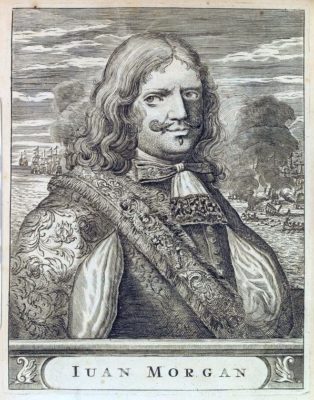
Sir Henry Morgan was a buccaneer, governor and sailor of Wales. The son of a wealthy plowman, he left his home to live in Jamaica, where he began to associate with other buccaneers of the time, such as Christopher Myngs and the Dutchman Eduard Mansvelt, of whom he was his disciple.
In collusion with the Jamaican governors, under British rule, and during various political tensions with the powers of the time, he began several military campaigns against the Spanish possessions in the Caribbean Sea area. He carried out his first large-scale operation in 1668, sacking the city of Port-au-Prince (now Camagüey) in Cuba, and ended with Panama City in 1670. At this place, despite poor conditions for crossing the Isthmus of Panama through the forest, and with an obvious disadvantage of men and armament, he demonstrated his qualities of command by leading a band of looters until obtaining the victory.
Despite the violence committed during his expeditions to America, he was made a knight by King Charles II of England in 1674 and served as lieutenant governor of Jamaica, where he served to persecute pirates in the region. During his last years of life, he suffered from poor health. Upon his death, his remains were buried in Palisadoes Cemetery in Port Royal.
Looting of Portobelo
Despite the success in Port-au-Prince and the buccaneer support from Jamaica, the crew were not satisfied. Under these circumstances, Morgan encouraged them not to falter and promised them more wealth. Having at this time a fleet of 8 boats and 400 men, he revealed his plan to Modyford to attack the city of Portobelo in Panama, the third best defended city after Havana and Cartagena de Indias in the Caribbean region. His subordinates were appalled by the proposal, but Morgan assured them they would have the “surprise” factor in their favor. During the voyage to the coast of Central America, another contingent joined, so that their troop increased to 460 men and nine ships.
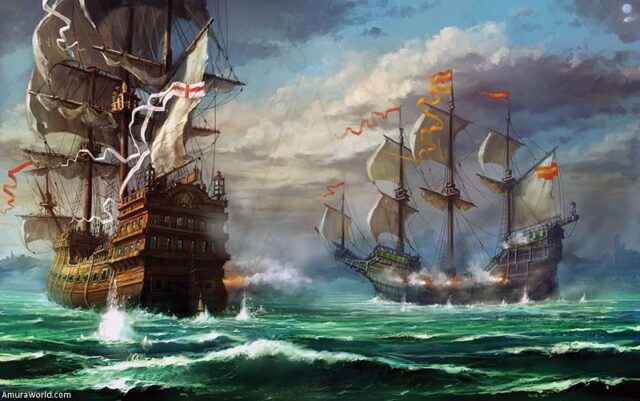
In the moments leading up to the attack, the fleet rounded the coast and subsequently landed with small boats. During the journey, they captured a Spanish sentry in the Longalemo estuary, who from then on served as their guide. The plan of attack was to reach the city by land, where the city was less protected. The buccaneers abandoned their boats about 5 km from Portobelo and began the march. At dawn, the first objective was Santiago Castle, which was taken without apparent difficulty. Once inside, they were blown up a powder warehouse with all the Spanish soldiers locked inside. They immediately headed for the fort of San Jerónimo, but the Spaniards resisted the assault. Faced with the delay of victory, the filibuster employed a cruel ploy: he ordered a group of elders, nuns and priests to assemble and forced them to stand at the foot of the wall to protect the ladders that the attackers were going to. to climb. Faced with a first warning from Morgan to the captain of the castle on the fate of the unfortunate, the officer refused to surrender and ignored the presence of the hostages, who, according to Exquemelin:
… Shouted [to the governor] and prayed to all the saints in heaven to abandon the castle to save them and the lives of the poor nuns.
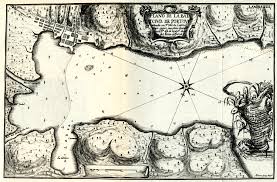
The buccaneers took the city at dusk, as the castle captain never gave up. Finally, the soldier was surrounded and executed. A third fort, called San Felipe, was taken the next morning by surprise. In all, the attackers lost 70 men. However, there was a celebration in the face of victory. According to the Dutch columnist:
They began to eat with a good appetite, and to drink like sleeves, followed by insolence and filthy embraces with many honest women and young girls, who, threatened with a knife, delivered their bodies to the violence of soulless men.
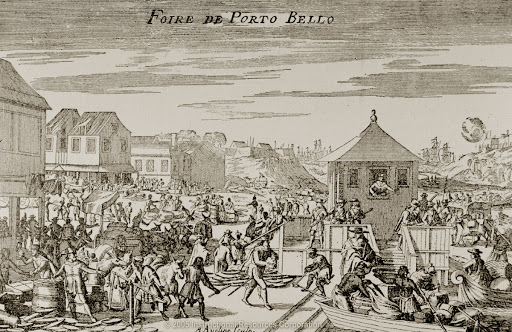
The events occurred in July 1668 and lasted for about fifteen days.
In addition to the looting, Morgan demanded 100,000 ¨reales¨ of eight as a burning tribute. Meanwhile, from Panama City, the troops of Governor Don Juan Pérez Guzmán arrived with a contingent of soldiers who were shot dead by the attackers. Later, according to historian Pedro Pérez Valenzuela, Guzmán ordered the buccaneers to leave the city, but Morgan refused. In response, the governor gave up organizing a new battalion and left the city and its inhabitants. Therefore, the neighbors decided to accept the demands and pay what was demanded. In Cuba, a booty of 250,000 pesos was distributed to a satisfied crew. Morgan’s reputation increased among pirates in the region after this attack.
According to Exquemelin’s accounts, Guzmán sent a message to the Welshman, impressed by the capture of Portobelo with so few men (400 according to the chronicler) and asked for a weapon used during the attack; Morgan did it that way, with a few bullets and with the message to keep them for a year, because he would come back for them. The governor, for his part, returned the gifts, with a gold ring, and with the answer that he should not bother to return to Portobelo, since he would not find it in the state in which he had found it this time.
On his return to Jamaica, Morgan manipulated the report of the action in front of Modyford, claiming that he had rescued 11 Englishmen from detention in Portobelo, without telling them of their outrages. Apart from that, of the booty he gave the corresponding percentages to the British king. Modyford, in turn, reported to the crown at his convenience, asserting his helplessness in the face of filibuster actions.
Looting of Panama City
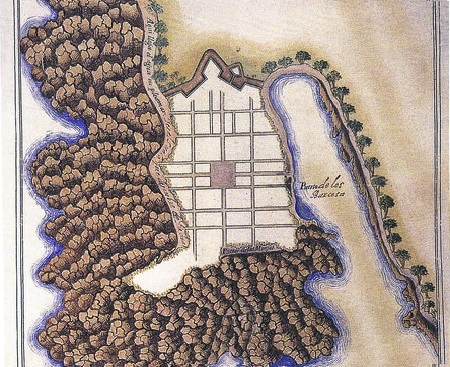
Between the years 1667 and 1670, treaties were signed between Spain and England that would end disputes between the two powers and promote business relations. However, a year after Morgan returned to Jamaica, new rumors have circulated of future Spanish attacks to reclaim the island. In addition, news of attacks on English fishing boats and merchants spread. On the other hand, according to Exquemelin, the buccaneers needed money to pay off their many debts in Jamaica due to their excesses at Port Royal. Whatever the reason, the pirates knew their operations would end soon, so they rushed to prepare an attack on the Spanish possessions. Morgan was apparently the only one capable of starting a large-scale action; even when it was linked to the new times which proclaimed peace. Apparently, the fact that legitimized an attack was an offensive by a certain Captain Rivero who, with a letter from the Governor of Cartagena de Indias, launched provocations against pirates near Cuba and a village in northern Jamaica.
Faced with the facts, the Jamaican governor instructed Morgan on August 1, 1670 to attack enemy ships and maintain peace on the island. He was appointed admiral and commander-in-chief of the entire war fleet. According to Exquemelin, the Welshman was planning to leave for Port Couillion, opposite Vaca Island, where he would reunite the buccaneers with the plan to mount an attack. Knowing of such intentions, Modyford prevented him from carrying out any action on the Spanish lands, knowing they would come together anyway. The meeting took place on October 24, 1670. Most of the adventurers followed Morgan because they knew he would make them rich.
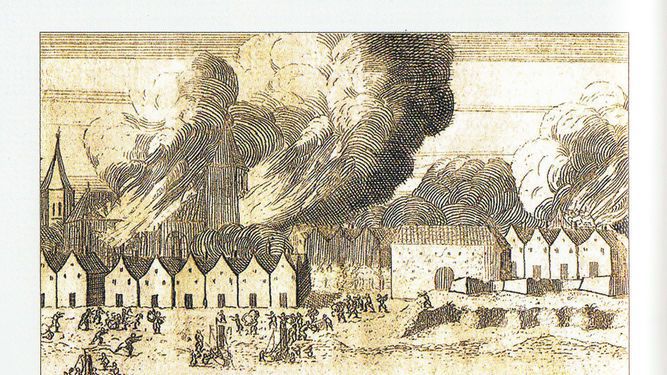
In view of the large-scale operation, the fleet was divided into three divisions to resupply themselves adequately: one would plunder the neighboring coasts for grain, another would go hunting and the third would remain on the island for shipbuilding. After the preparations, the fleet numbered 37 ships and at least 2,000 men. Also, during the stay, the rewards and indemnities to be attributed to the combatants of the expedition were arranged. In this case, the captains would receive “the share of eight sailors for the expenses of each ship”, and if there were mutilations in any of the buccaneers, they would be compensated according to their severity. For example, 1,500 pieces of eight to fifteen slaves would be awarded for the loss of both legs. Morgan knew the only way to get one of his crew to fight was to pay him.
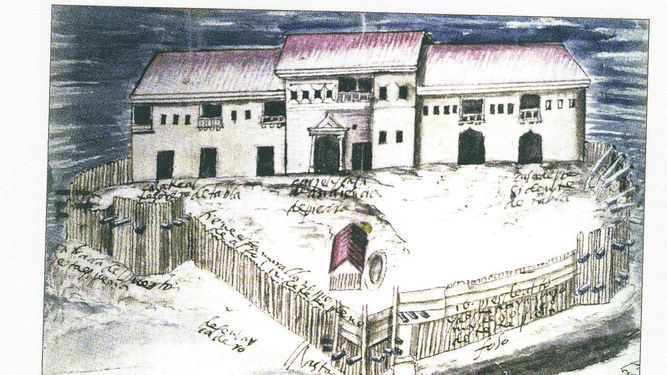
Three targets were considered for the assault: Cartagena de Indias, Veracruz and Panama City. The choice fell on the latter, because of its great commercial activity due to the commercial transit between the Pacific and Atlantic oceans. In addition, it was the point of arrival for the Peruvian silver fleet. On the other hand, it was the least protected locality and depended on the jungle for its protection. Ahead of the campaign, Morgan urged his men to act on the Spaniards as “avowed enemies … of the King of England, their so-called lord.”